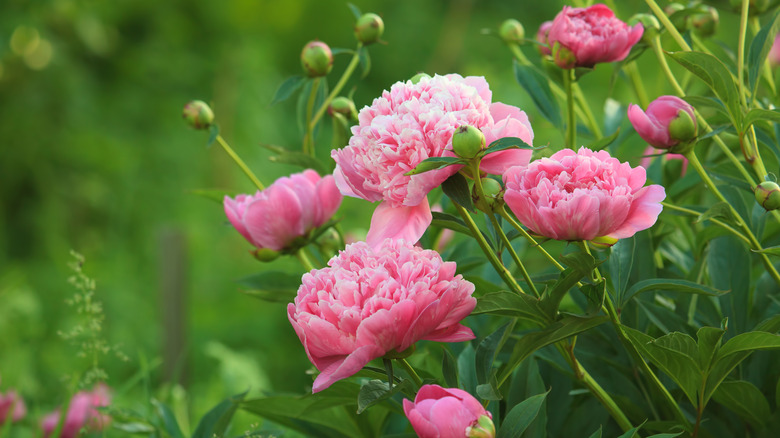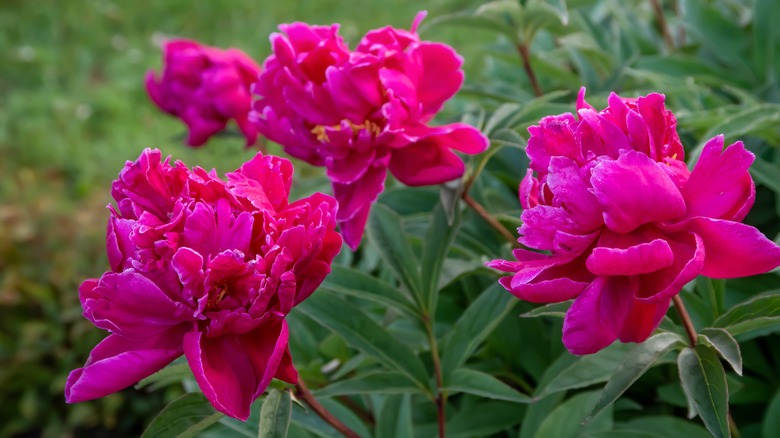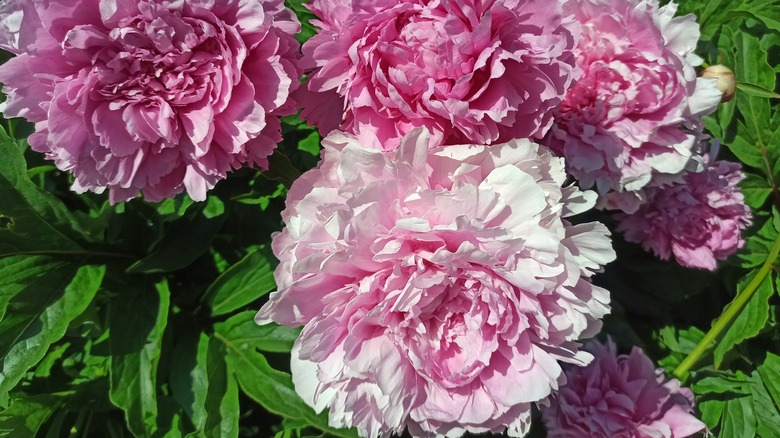Avoid Making This Crucial Mistake When Caring For Your Peonies In The Fall
Peonies are a beloved garden perennial. Their gorgeous, dependable spring blooms in shades of red, white, and pink make them a classic choice for formal or cottage gardens. They're also excellent cut flowers. Peonies are long-lived and fairly easy to care for, but some particular aspects of their growing conditions need observing to keep them healthy. One thing you must keep in mind is that you should never use fertilizer on your peonies in the fall.
The reason for this? Fertilizer added in autumn may cause your plant to put out growth, which might make it vulnerable to cold weather damage. Also, stimulating growth during the peony's dormant season may affect its ability to bloom the following season. A successfully grown peony needs a period of cold to rest and replenish its energy so it can form buds and flower in the spring.
High-nitrogen fertilizers are particularly harmful to peonies at this stage in the growing cycle. To play it safe, avoid using any fertilizers in the fall, and only fertilize your peony in the spring right after buds appear. If yours has healthy, well-draining soil — and is planted in a good spot with plenty of sun — it shouldn't ever need fertilizers to form healthy blooms year after year.
How to nourish peonies
The greatest food for peonies is rich garden soil. When planting, ensuring they have plenty of well-draining, loamy soil is the best way to give them a good start. Once your peonies are established, they shouldn't need extra fertilizers. However, if you want to give them an extra boost in their first two or three years, a bit of balanced fertilizer in spring after buds appear may help the flowers become more vibrant. But mature peonies shouldn't need fertilizer and will still reward you with beautiful blooms each year.
Peonies do enjoy some nourishment in the fall, however, to help feed them slowly during the winter months. It's recommended that you put a light layer of aged manure or compost around the base of your peonies. This is called "top dressing," and it adds some nutrients to the soil to be released slowly over the dormant period — preparing your peony for its active growth period starting in spring. Peonies like slightly acidic soil, so if you use mulch, a type of natural mulch, like shredded pine bark, breaks down slowly and adds some slightly acidic nutrients to the soil over time. Another soil amendment that helps acidity is used coffee grounds. These can be mixed in with your compost or manure and added to the top dressing in the fall. These amendments are also good for improving soil drainage, which helps peonies avoid root rot.
Improving blooms on your peonies
When gardening with peonies in the fall, there are a few things to do to get them ready for winter. Autumn is the time to prune them back, and also, if you want to divide or move them, you should do this before the cold weather sets in. Peonies are very cold-hardy plants, but they need to be planted at the proper depth for the flowers to develop. Peonies get small bud-like growths called "eyes" on their roots; these pink or white eyes later become new stems with buds. Occasionally, you may see the top of an eye poking through the soil, and this means the base of the peony has become exposed (possibly by heavy rain or some wildlife). The eyes should be two to three inches beneath the surface of the soil, so if you see any poking through, add some soil over the top to make sure the roots are properly covered.
If you're concerned about your peony not blooming properly, there may be two other factors to consider. First, it may not be getting enough sun. Peonies are long-lived, and over time, mature peonies may get over-shaded by trees or shrubs as they grow. If so, they'll need to be relocated to a sunnier spot. Another factor may be planting depth; if peonies are planted too deep, they may struggle to form good buds.


